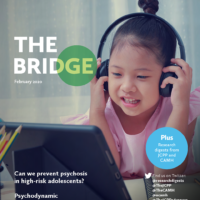ACAMH Website Content Types
-

Environmental factors linked with identifying as a sexual minority may increase suicidality risk
Adolescents who identify as a sexual minority (e.g., gay/lesbian, bisexual) are at an increased risk for suicidality compared to their heterosexual counterparts.1 Until now, inherent limitations in study design has meant that the extent of this association has been unclear.
Read more -

EEG data might help identify children at risk for social anxiety
Electroencephalography (EEG) is a non-invasive method to monitor the electrical activity of the brain. There are five main broad frequency bands in the EEG power spectrum: alpha, beta, gamma, delta and theta. Data suggest that EEG-derived delta–beta coupling — indicating related activity in the delta and beta frequency bands — might serve as a marker of emotion regulation.
Read more -

Does early androgen exposure contribute to autistic traits?
Researchers in Hong Kong and Cambridge have explored the influence of early androgen exposure on autistic traits during childhood.
Read more -

Cord blood metabolites linked with an ADHD diagnosis in childhood
Researchers in the USA have analysed whether the levels of branched-chain amino acids (BCAAs) detectable in maternal plasma and newborn cord blood are associated with the development of attention-deficit hyperactivity disorder (ADHD) later in childhood.
Read more -

Childhood behaviour patterns linked with romantic partnering in adulthood
Children with behavioural disorders, such as ADHD or conduct disorder, are more likely to experience partnership problems in adulthood, including partner conflict and lower relationship satisfaction.
Read more -

Which genetic mechanisms underlie the relationship between preschool vocabulary and later literacy skills?
Preschool vocabulary acquisition is associated with later language and literacy skills. Genetic factors might partially explain this link, but the precise mechanisms are unclear. Thus far, twin-based studies have implicated mechanisms involving genetic amplification or genetic innovation.
Read more -

Progressive cortical thinning might identify children at risk of developing psychotic spectrum symptoms
Offspring of patients with schizophrenia or bipolar disorder have an increased risk of developing these conditions. However, our capacity to predict the long-term outcomes of these at-risk individuals is limited. Now, researchers have investigated whether longitudinal changes in brain structure differ in individuals at high familial risk who develop psychotic spectrum symptoms, compared to those who do not and to low-risk controls.
Read more -

How far have we advanced this decade in understanding reading disorders?
Earlier this year, Margaret Snowling and Charles Hulme at the University of Oxford compiled an Annual Research Review for the Journal of Child Psychology and Psychiatry on reading disorders.
Read more -

Chronic illness may present barriers to engaging in CBT for depression
Between 10 and 20% of teenagers have a chronic illness:1 an ongoing health condition that lasts at least 3 months, and for which a cure is unlikely. Research suggests that teenagers with chronic illnesses are more likely to also have low mood and develop depression than their healthy peers.2
Read more -

February 2021 – The Bridge
This issue of The Bridge includes several articles which focus on child and adolescent psychoanalytic psychotherapy. This therapy aims to help young people, their families, or their support networks to better understand each young person’s emotions, behaviour, and relationships.
Read more